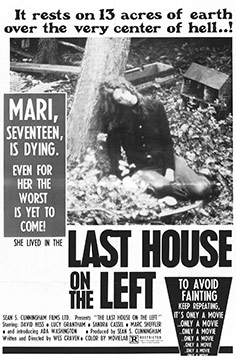"It's only a movie"
 CREDIT: THIS FAMOUS POSTER OFFERS THE AUDIENCE SOME ADVICE.
CREDIT: THIS FAMOUS POSTER OFFERS THE AUDIENCE SOME ADVICE.HALLMARK RELEASING CORP.
Up until his untimely death this past August, Wes Craven spent his career as a legendary writer, director, editor and producer conjuring some of the most menacing and well-crafted entries in American horror. Yet of all of Craven's films, there is none more stirring and provocative than his 1972 directorial debut, The Last House on the Left.
The Last House tells the story of the rape and murder of countryside teenagers Mari Collingwood and Phyllis Stone at the hands of an urban gang. Later, Mari's parents unwittingly invite the disguised gang into their home and then kill them after realizing what they have done.
The original cut of the film was naturally met with contention by the general public and substantially censored as a result. It was this controversy that prompted the use of the film's famous tagline, which encouraged prospective viewers to “keep repeating ‘it's only a movie'” lest they be shocked at the movie's highly graphic content.
However, The Last House on the Left is not only a movie, nor is it like any other horror film in the traditional sense. When asked to describe the conventions of horror, one is more likely to envision a plot featuring supernatural monstrosities instead of standard news headlines. But as the epigraph of The Last House on the Left so honestly warns prospective viewers, “The events you are about to witness are true”. Ghosts and goblins need not apply.
While his following movies were backed by Hollywood funds, The Last House on the Left depends solely on Craven's editing abilities paired with the casts' raw performances to effectively generate a manic rise to a violent climax before plummeting into a realm of grief, remorse and murderous rage.
At least part of the movie's genius lies in this, as it purposefully contrasts the rapists' exhilaration leading up to their crime with its painful consequences when they later confront Mari's vengeful parents.
The Last House on the Left is a story of crime and punishment and provides a detailed portrait of the people involved, including the murderers.
“What would you do if you were me,” cried a by-standing young gang member as Mari begs for her life. This line epitomizes the film as it lures audiences into wondering what they would do if they saw something awful happening right before their eyes but felt powerless to stop it.
Recalling the movie's opening line, “The events you are about to witness are true,” the full horror of The Last House on the Left becomes clear. Just as Mari's rape takes place in the woods across the street from her childhood home, horrible events often take place close by and by people whom we least expect. As unsettling as this film may be, it nevertheless deserves to be commended for the way it subverts conventional horror by redirecting audiences from fantasy to the real world, where more often than not true evil lies just outside our door. Keeping this in mind, Craven seems to ask us: will we know it when we see it?
















